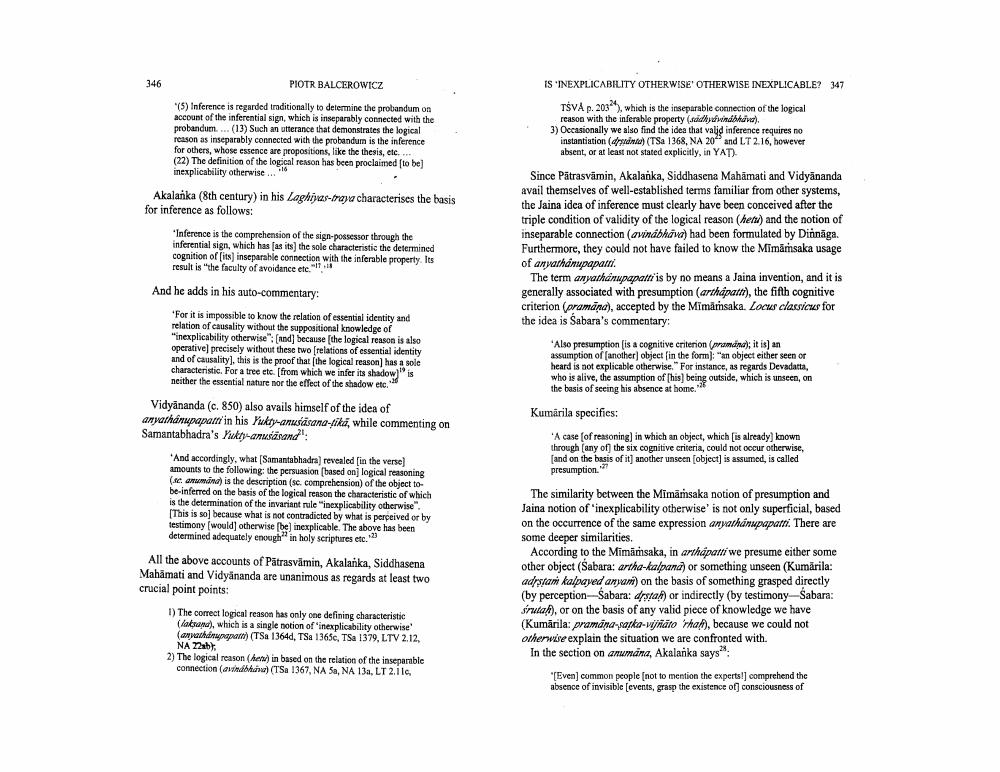Book Title: Is Inexplicability Otherwise Otherwise Inexplicable Author(s): Piotr Balcerowicz Publisher: Piotr Balcerowicz View full book textPage 3
________________ 346 PIOTR BALCEROWICZ (5) Inference is regarded traditionally to determine the probandum on account of the inferential sign, which is inseparably connected with the probandum.... (13) Such an utterance that demonstrates the logical reason as inseparably connected with the probandum is the inference. for others, whose essence are propositions, like the thesis, etc..... (22) The definition of the logical reason has been proclaimed [to be] inexplicability otherwise... 16 Akalanka (8th century) in his Laghiyas-traya characterises the basis for inference as follows: *Inference is the comprehension of the sign-possessor through the inferential sign, which has [as its] the sole characteristic the determined cognition of [its] inseparable connection with the inferable property. Its result is "the faculty of avoidance etc." And he adds in his auto-commentary: *For it is impossible to know the relation of essential identity and relation of causality without the suppositional knowledge of "inexplicability otherwise": [and] because [the logical reason is also operative] precisely without these two [relations of essential identity and of causality], this is the proof that [the logical reason] has a sole characteristic. For a tree etc. [from which we infer its shadow" is neither the essential nature nor the effect of the shadow etc." Vidyananda (c. 850) also avails himself of the idea of anyathanupapatti in his Yukty-anusasana-tika, while commenting on Samantabhadra's Yukty-anusäsand: And accordingly, what [Samantabhadra] revealed [in the verse] amounts to the following: the persuasion (based on] logical reasoning (se anumana) is the description (sc. comprehension) of the object tobe-inferred on the basis of the logical reason the characteristic of which is the determination of the invariant rule "inexplicability otherwise". [This is so] because what is not contradicted by what is perceived or by testimony [would] otherwise [be] inexplicable. The above has been determined adequately enough" in holy scriptures etc. 23 All the above accounts of Patrasvämin, Akalanka, Siddhasena Mahamati and Vidyananda are unanimous as regards at least two crucial point points: 1) The correct logical reason has only one defining characteristic (laksana), which is a single notion of 'inexplicability otherwise' (anyathinupapart) (TSa 1364d, TSa 1365c, TSa 1379, LTV 2.12, NA 22ab) 2) The logical reason (het) in based on the relation of the inseparable connection (avindbhava) (TSa 1367, NA 5a, NA 13a, LT 2.11. IS 'INEXPLICABILITY OTHERWISE OTHERWISE INEXPLICABLE? 347 TSVA p. 203), which is the inseparable connection of the logical reason with the inferable property (sadhydvinábháva). 3) Occasionally we also find the idea that valid inference requires no instantiation (dranta) (TSa 1368, NA 20 and LT 2.16, however absent, or at least not stated explicitly, in YAT) Since Pātrasvāmin, Akalanka, Siddhasena Mahamati and Vidyananda avail themselves of well-established terms familiar from other systems, the Jaina idea of inference must clearly have been conceived after the triple condition of validity of the logical reason (het) and the notion of inseparable connection (avindbhava) had been formulated by Dinnaga. Furthermore, they could not have failed to know the Mimamsaka usage of anyathanupapatti. The term anyathanupapatti is by no means a Jaina invention, and it is generally associated with presumption (arthapatti), the fifth cognitive criterion (pramāna), accepted by the Mimämsaka. Locus classicus for the idea is Sabara's commentary: *Also presumption (is a cognitive criterion (pramana); it is) an assumption of (another) object (in the form]: "an object either seen or heard is not explicable otherwise." For instance, as regards Devadatta, who is alive, the assumption of [his] being outside, which is unseen, on the basis of seeing his absence at home." Kumārila specifics: 'A case [of reasoning) in which an object, which [is already] known through [any of] the six cognitive criteria, could not occur otherwise, [and on the basis of it] another unseen [object] is assumed, is called presumption. The similarity between the Mimamsaka notion of presumption and Jaina notion of 'inexplicability otherwise' is not only superficial, based on the occurrence of the same expression anyathanupapatti. There are some deeper similarities. According to the Mimämsaka, in arthapatti we presume either some other object (Sabara: artha-kalpana) or something unseen (Kumārila: adrstam kalpayed anyam) on the basis of something grasped directly (by perception-Śabara: drstan) or indirectly (by testimony-Śabara: śruta), or on the basis of any valid piece of knowledge we have (Kumārila: pramāṇa-satka-vijñāto 'rha), because we could not otherwise explain the situation we are confronted with. In the section on anumana, Akalanka says": "[Even] common people [not to mention the experts!] comprehend the absence of invisible [events, grasp the existence of] consciousness ofPage Navigation
1 2 3 4 5 6 7 8 9 10 11 12 13 14 15 16 17 18 19 20
